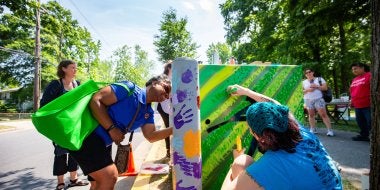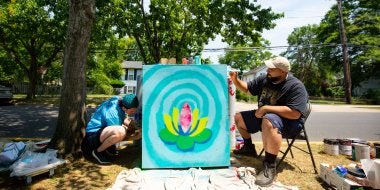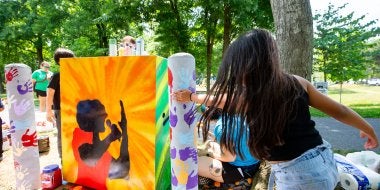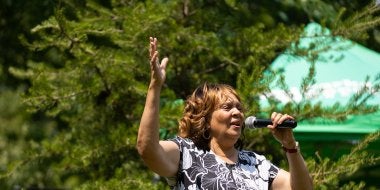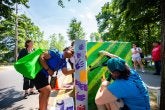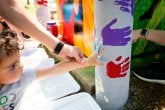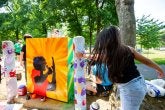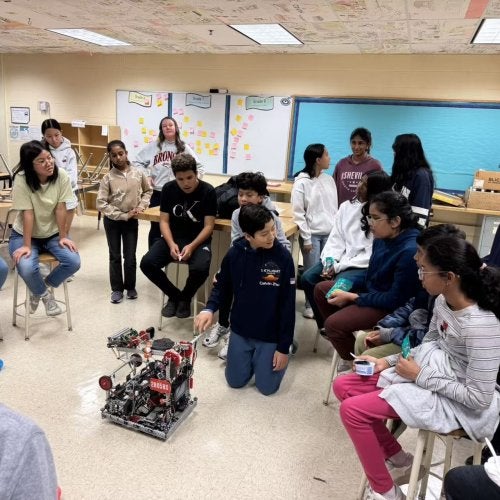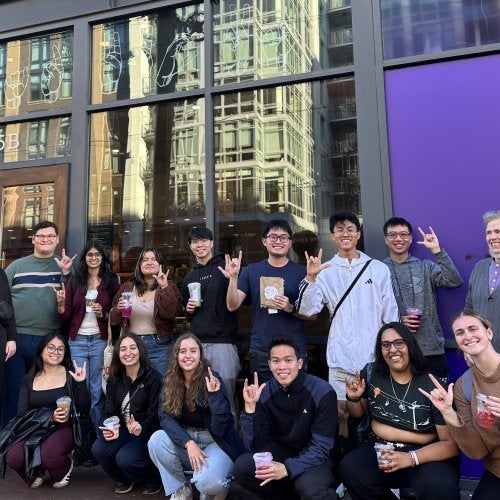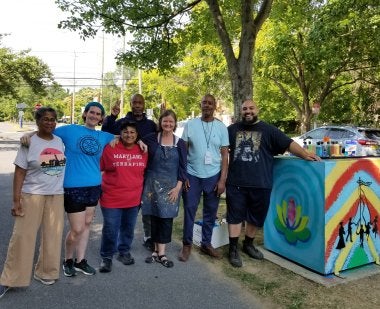
On a sunny June afternoon, an eight-year-old girl coated her hand with thick, pastel blue paint and pressed it against a plain gray pole in the local park.
“Look at that! Beautiful,” exclaimed Margaret Walker ’91, clinical associate professor of art education and arts integration and an alum of the University of Maryland College of Education. “Now the handprint will always be there.”
Soon, two gray poles were covered in colorful handprints, contributed by members of the Lakeland community of College Park. The poles flanked an electrical box, once painted a shade of matching gray and now covered in an explosion of color. Each side of the box featured a silhouette representing a significant theme in the neighborhood’s history and culture, chosen by community elders.
The community-based art project was prompted by the City of College Park’s ongoing restorative justice work to renounce systemic racism and acknowledge and address the ways the city and other agencies have harmed Lakeland in the past. From the 1960s to the mid-1980s, an urban renewal project decimated the flourishing, historically African American community, displacing 70% of its households. Most residents were never able to return to the neighborhood.
Walker reached out to the Lakeland Civic Association in February to begin a collaboration. Community leaders, along with Walker and graduate students in her Community-Based Art Education course, surveyed and met with residents to gather their ideas and wishes for the project. Then, over four Saturdays in May and June, community members gathered with Walker and her students in Lakeland to make art together.
“The community agreed to work with us for two reasons,” said Walker. “One was to beautify the neighborhood by creating artwork that celebrates the history and amplifies the existing neighborhood as a thriving community. The second reason was to help educate the university about their story.”
During meetings that shaped the art project, elders shared stories about what Lakeland was like before urban renewal, and residents of all ages discussed what they valued most about the neighborhood. The community identified the electrical box as the focus of the project and also chose to create a mural that will decorate a sign in a future pocket park in Lakeland.
Ruth Murphy ’86, vice president of the Lakeland Civic Association and a College of Education alum, is a former public school teacher whom Walker calls her “partner in art.”
“Like me, [Walker] believes that we bring people together through the arts,” said Murphy. “When residents can see that people from the university are interested in learning about the community, then the community will spend time reminiscing and also talking about how we’ve been trampled upon. That only comes when you trust each other.”
The silhouettes on each side of the box reflect elders’ strongest memories of and connections with Lakeland. The first silhouette depicts a maypole surrounded by dancers dressed in styles dating from the community’s founding in 1890 and to the present. The maypole dance was a significant tradition at Lakeland's high school and elementary school. Lakeland High School, which opened in 1928 to serve African American students from across northern Prince George’s County during segregation, became a cultural center for African American families in the area. The second image, a lotus flower, is a symbol of Lakeland that represents the natural beauty of the neighborhood and nearby Lake Artemesia. A baseball player symbolizes the baseball diamond that once served as a major gathering place in Lakeland. A singer, based on a photo of Lakeland resident Angie Bass, represents Lakeland's entertainment venues such as its tavern, fondly known as the Beer Garden, which were once social hubs for music and dance.
“When we work together in art making, stories are shared and histories are understood,” said Walker. “It would really help society if people made more art together, especially with people they might not normally encounter.”
Samir Razzak, M.Ed. ’24, graduate assistant for the project, sketched the silhouettes with real-time feedback from residents and later used stencils and spray-paint to affix the final designs onto the electrical box. A Lakeland resident suggested the idea of placing handprints on the poles so that community members who contributed could walk by and recognize a part of themselves in the art in perpetuity.
“The community needs to be the center of this whole project,” said Razzak, a master’s student in teacher leadership and education with art education integration. “And as you look around [the park today], they really are.”
The project was funded by a $12,500 Teaching and Learning Innovation grant from the university’s Teaching & Learning Transformation Center.
